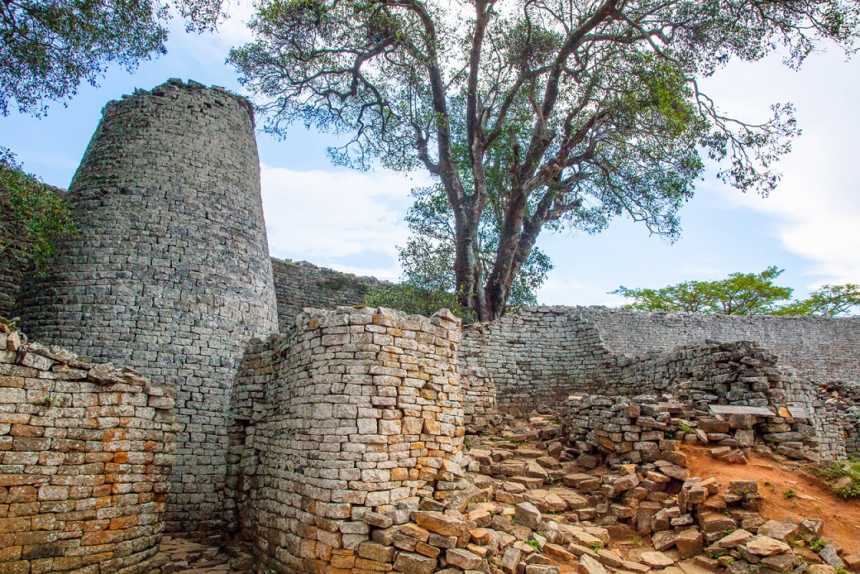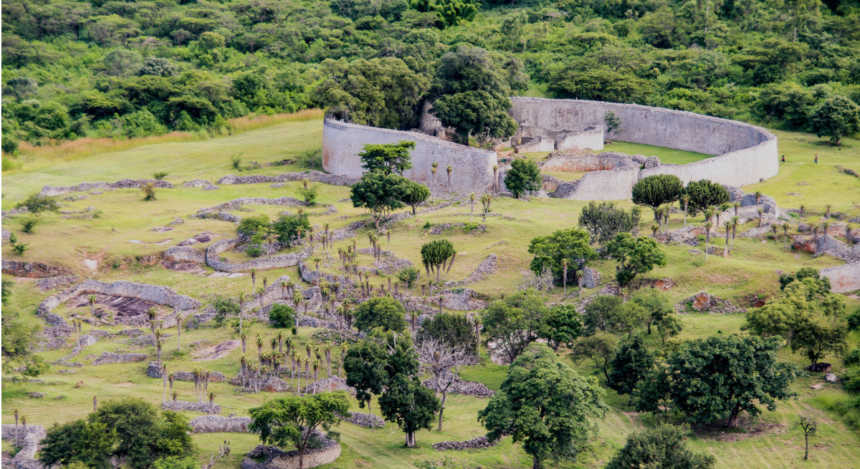Great Zimbabwe has been described as “one of the most dramatic architectural landscapes in sub-Saharan Africa.” This site was once connected to the mighty civilization of Great Zimbabwe and the finds have significantly added to our knowledge of the region’s past.
The ruins that survive are a four-hour drive south of Zimbabwe’s present-day capital of Harare. It was constructed between the 11th and 15th centuries and was continuously inhabited by the Shona peoples until about 1450 (the Shona are the largest ethnic group in Zimbabwe). But Great Zimbabwe was by no means a singular complex—at the site’s cultural zenith, it is estimated that seven comparable states existed in this region.
Much of Great Zimbabwe is unexcavated and what the different enclosures were used for is a source of debate among archaeologists. The earliest written records for the city date to the 16th century, a time after it was largely abandoned.
Great Zimbabwe is the largest stone complex in Africa built before the modern era, aside from the monumental architecture of ancient Egypt.
The word zimbabwe translates from the Bantu language of the Shona to either “judicial center” or “ruler’s court or house.” A few individual zimbabwes (houses) have survived exposure to the elements over the centuries. Within these clay structures, excavations have revealed interior furnishings such as pot-stands, elevated surfaces for sleeping and sitting, as well as hearths. Taken together, the settlement encompasses a cluster of approximately 250 royal houses built of clay, which in addition to other multi-story clay and thatch homes would have supported as many as 20,000 inhabitants—a exceptional scale for a sub-Saharan settlement at this time.
Unparalleled architecture
The city’s buildings were made of impressive granite walls, embellished with turrets, towers, decorations and elegantly sculpted stairways. The whole site is weaved with a centuries-old drainage system which still works, funneling water outside the houses and enclosures down into the valleys.
The stone constructions of Great Zimbabwe can be categorized into roughly three areas: the Hill Ruin (on a rocky hilltop), the Great Enclosure, and the Valley Ruins.

The Hill Ruin dates to approximately 1250, and incorporates a cave that remains a sacred site for the Shona peoples today. The cave once accommodated the residence of the ruler and his immediate family. The Hill Ruin also held a structure surrounded by 30-foot high walls and flanked by cylindrical towers and monoliths carved with elaborate geometric patterns.
The Great Enclosure was completed in approximately 1450, and it too is a walled structure punctuated with turrets and monoliths, emulating the form of the earlier Hill Ruin. The massive outer wall is 32 feet high in some places. Inside the Great Enclosure, a smaller wall parallels the exterior wall creating a tight passageway leading to large towers. Because the Great Enclosure shares many structural similarities with the Hill Ruin, one interpretation suggests that the Great Enclosure was built to accommodate a surplus population and its religious and administrative activities. Another theory posits that the Great Enclosure may have functioned as a site for religious rituals.
The third section of Great Zimbabwe, the Valley Ruins, include a number of structures that offer evidence that the site served as a hub for commercial exchange and long distance trade. Archaeologists have found porcelain fragments originating from China, beads crafted in southeast Asia, and copper ingots from trading centers along the Zambezi River and from Central African kingdoms.
The Walls of Great Zimbabwe

All of the walls at Great Zimbabwe were constructed from granite hewn locally. Millions of blocks of stone went into the walls of Great Zimbabwe. It must have taken many years, certainly decades, to complete it. It was accomplished by about the year 1300 or so.
While some theories suggest that the granite enclosures were built for defense, these walls likely had no military function. Many segments within the walls have gaps, interrupted arcs or elements that seem to run counter to needs of protection. The fact that the structures were built without the use of mortar to bind the stones together supports speculation that the site was not, in fact, intended for defense. Nevertheless, these enclosures symbolize the power and prestige of the rulers of Great Zimbabwe.
The conical tower of Great Zimbabwe is thought to have functioned as a granary. According to tradition, a Shona ruler shows his largess towards his subjects through his granary, often distributing grain as a symbol of his protection. Indeed, advancements in agricultural cultivation among Bantu-speaking peoples in sub-Saharan Africa transformed the pattern of life for many, including the Shona communities of present-day Zimbabwe.

Wealth and trade
Archaeological debris indicate that the economy of Great Zimbabwe relied on the management of livestock. In fact, cattle may have allowed the Shona peoples to move from subsistence agriculture to mining and trade. Iron tools have been found on site, along with copper, and gold wire jewelry and ornaments.
Great Zimbabwe is thought to have prospered, perhaps indirectly, from gold that was mined 25 miles from the city. More than 4,000 gold and 500 copper mines were found around the site, and it was suggested that for three centuries, 40% of the world’s total mined gold came from the area, compounding to an estimated 600 tonnes of gold. Thousands of necklaces made of gold lamé have been discovered among the ruins.

Decline of the Great Zimbabwe
The period of prosperity at Great Zimbabwe continued until the mid-15th century, when the city’s trading activity started to decline and its people began to migrate elsewhere. Causes for the decline and ultimate abandonment of the site have been suggested as due to a decline in trade compared to sites further north, the exhaustion of the gold mines, political instability and famine and water shortages induced by climatic change. But the precise cause remains unclear.
Today, the ruins of Great Zimbabwe are a shell of the abandoned city that Captain Pegado came across – due in no small part to the frenzied plundering of the site at the turn of the 20th century by European treasure-hunters, in search of artefacts that were eventually sent to museums throughout Europe, America and South Africa.

Plunder and Misappropriation
When European explorers arrived in the area in the 19th and early 20th centuries, they took artifacts from the ruins of Great Zimbabwe and put forward claims that the city wasn’t built by Africans at all, claiming that it was built by the Phoenicians or other groups from Asia or Europe.
The earliest European to describe Great Zimbabwe was Karl Mauch. He lived from 1837 to 1875 and claimed Great Zimbabwe was an African replica of palace where the Queen of Sheba, a character mentioned in the Hebrew Bible, lived during her visit to Solomon. He refused to believe that indigenous Africans could have built such an extensive network of monuments.
Other European writers, also believing that Africans did not have the capacity to build anything of the significance of Great Zimbabwe, suggested it was built by Portuguese travellers, Arabs, Chinese or Persians. Another theory was that the site could have been the work of a southern African tribe of ancient Jewish heritage, the Lemba.
However, archaeologists have long since dismissed claims that Great Zimbabwe was built by Phoenicians, people from Europe or the Queen of Sheba. Today, scholars widely believed that Great Zimbabwe was built by the ancestors of the Shona and other groups located in Zimbabwe and nearby countries.

Political and ideological battles have also been fought over the ruins. In 1890, the British mining magnate and coloniser Cecil Rhodes financed archaeologist James Theodore Bent, who was sent to South Rhodesia by the British Association of Science with instructions to “prove” the Great Zimbabwe civilisation was not built by local Africans.
The government of Ian Smith, prime minister of Southern Rhodesia (modern Zimbabwe) until 1979, continued the colonial falsification of the city’s origins in official guide books, which showed images of Africans bowing down to the foreigners who had allegedly built Great Zimbabwe.
Reclaiming the Past
Great Zimbabwe stands as one of the most extensively developed centers in pre-colonial sub-Saharan Africa and stands as a testament to the organization, autonomy, and economic power of the Shona peoples. The site remains a potent symbol not only to the Shona, but for Zimbabweans more broadly.
Despite the importance of Great Zimbabwe, much of it is unexcavated. “If we combine areas dug by antiquarians with those by professional archaeologists, it becomes clear that the excavated area at Great Zimbabwe is less than 2 percent,” wrote a team of scientists who are remapping the city in a paper published in 2016 in the Journal of Archaeological Method and Theory.
Today, Great Zimbabwe is a UNESCO World Heritage Site and is considered a sort of national symbol for the modern-day country of Zimbabwe. The nation adopted the name Zimbabwe in 1980, using the name that the Shona had long before given to the city. Also the flag of Zimbabwe shows a bird sitting on a pedestal, which is a representation of a type of artifact found at Great Zimbabwe.



